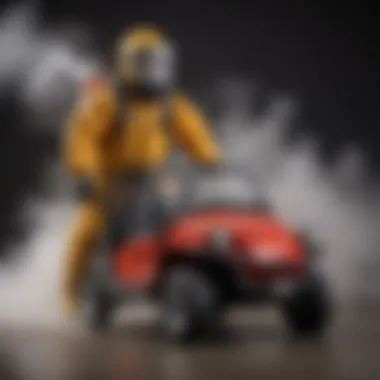Understanding Auto Fumigation: Techniques and Applications


Intro
Auto fumigation is a pivotal process in pest control, attending to the intricate dance of nature where pests invade spaces meant for human habitation. With the rise of integrated pest management strategies, understanding auto fumigation becomes essential for homeowners and pest management professionals alike. This section delineates its core components, weaving together methodologies, benefits, and safety measures. It is crucial to establish a solid ground on pest identification and prevention, which set the stage for the effective application of auto fumigation techniques.
Understanding Pests
Definition of Pests
In ecological contexts, pests are organisms that can cause damage to crops, structures, or even human populations. They encompass a wide range of species including insects, rodents, and other vermin. These organisms can disrupt the balance in residential and agricultural settings, making effective pest control methodologies critically important.
Importance of Pest Identification
Identifying pests accurately is the first step in any pest control strategy. Not all pests are equal; some may be nuisance species while others can inflict significant damage. Recognizing these differences helps to tailor a pest control approach. Homeowners should observe signs of infestations, such as droppings, structural damage, or audible noises. Tools like traps or monitoring devices can assist in this identification process.
Prevention Techniques
Home and Garden Preventative Measures
Prevention is always better than cure. Homeowners can implement several techniques to deter pest invasions before they start. Simple practices include:
- Sealing Entry Points: Cracks in walls, openings around pipes, and spaces around windows should be sealed to block potential access for pests.
- Regular Cleaning: Keeping areas clean and free of food debris minimizes attraction for pests, making homes less hospitable.
- Proper Waste Management: Securing waste containers and regularly clearing out garbage reduces the chance of pest infestations.
Seasonal Prevention Tips
Pests behave differently with seasonal changes, so strategies need to adapt accordingly. In spring and summer, for example, insects tend to thrive. It is advisable to:
- Inspect home exteriors regularly for early signs of infestations.
- Create barriers like mulch to deter pests from entering gardens.
- Use natural but effective repellents to safeguard plants during high-infestation seasons.
Eco-Friendly Pest Control Solutions
Overview of Sustainable Practices
Sustainable practices in pest management invest in controlling pests without degrading the environment or human health. Auto fumigation can be synchronized with eco-friendly approaches, ensuring minimal chemical usage. Techniques such as rotating crop types and employing beneficial insects are integral to sustainable pest control methodologies.
Natural Remedies and Their Effectiveness
Many household remedies exist for pest control. Some popular options include:
- Diatomaceous Earth: This powdery substance can be sprinkled in infested areas. It effectively dehydrates insects that come into contact with it.
- Essential Oils: Oils like peppermint or tea tree can serve as natural repellents. Mixing with water and spraying around the home can keep many pests at bay.
"Sustainable pest control requires the synthesis of effective techniques and a commitment to preserving environment integrity."
Preamble to Auto Fumigation
Auto fumigation is an essential process in pest management. It involves treating a structure using gaseous pesticides. This method can efficiently eliminate pests from homes and various facilities. Understanding auto fumigation is crucial for homeowners, who often need effective solutions to pest issues. Moreover, pest management professionals can benefit from grasping the methodologies involved. Such understanding can lead to better application strategies and outcomes in their work.
Definition of Auto Fumigation
Auto fumigation can be defined as the process of applying fumigants within a sealed environment. This process involves the use of specially designed equipment to disperse gaseous pesticides. The goal is to penetrate hidden places within structures. This includes cracks, crevices, and other difficult-to-reach areas. In practice, this means a thorough treatment that maximizes efficacy. The main advantage is that pests, including insects and rodents, are targeted directly at their nests or breeding sites.
Overview of Fumigation Techniques
Fumigation techniques can vary widely in application and execution. Some techniques include:
- Whole Structure Fumigation: This method entails sealing the entire building while introducing fumigants. It is commonly used for severe infestations and can target extensive areas effectively.
- Localized Fumigation: Here, specific areas of infestation are treated, which may be more economical for minor issues.
- Tenting: In this technique, a structure is covered with a tarpaulin to contain the fumigants. This is often employed in combination with whole-structure fumigation.
Each technique offers distinct benefits and has specific applications. Understanding these distinctions helps homeowners make informed decisions when faced with pest issues. The choice of technique may depend on factors like the type of pests, infestation severity, and building structure.
Historical Context


The historical context of auto fumigation is essential in understanding its evolution and current relevance in pest control. The roots of fumigation can be traced back to ancient practices, where various techniques were employed to combat pests. Knowledge of these historical practices illustrates how standards have changed over time. Furthermore, it sheds light on the innovations that have shaped modern auto fumigation methods.
Evolution of Fumigation Practices
Fumigation methods have steadily evolved since their inception. Early practices often involved the use of smoke from burning materials to deter pests. As societies advanced, more sophisticated techniques emerged. By the 19th century, chemical fumigants began to be utilized. This transition marked a significant turning point.
With the birth of modern chemistry, substances like sulfuryl fluoride and methyl bromide were introduced. These chemicals carried out the task with greater efficiency compared to traditional methods. The advancements in equipment also enhanced the delivery and effectiveness of these agents. By automating the process, auto fumigation expanded its relevance across different sectors, from residential homes to large agricultural operations.
Milestones in Auto Fumigation Development
Several key milestones have emphasized the importance of auto fumigation in contemporary pest management.
- 1920s: The introduction of gas chambers during this decade revolutionized how spaces were fumigated. Gas-tight structures enabled effective treatments without the risk of exposure.
- 1950s: The emergence of complex machinery designed for automated fumigation processes significantly improved accuracy and scale.
- 1990s: Stronger regulations led to the development of safer fumigants and refined methodologies, addressing both efficacy and environmental concerns.
"The transition to auto fumigation has made pest control more efficient, allowing for targeted strategies without considerable manual labor."
These milestones highlight not only the technological advancements but also underscore the ongoing commitment to safety and environmental considerations in pest management practices. Understanding these changes offers valuable insight into current techniques and applications of auto fumigation.
Mechanics of Auto Fumigation
Understanding the mechanics of auto fumigation is essential for grasping its applications and benefits in pest control. This section dissects how the process operates, the crucial components involved, and the considerations for selecting appropriate fumigants. Each aspect bears significance for homeowners seeking effective solutions to infestations, ensuring a thorough grasp of how auto fumigation can be utilized effectively.
How Auto Fumigation Works
Auto fumigation employs a methodical approach to pest eradication via gaseous substances that penetrate soft materials and reach areas that may be difficult to treat otherwise. The key principle involves hermetic sealing of the space to be treated.
Once a structure is sealed, a specific fumigant is released into the area. This process ensures that the gas disperses evenly throughout the enclosed space, targeting both visible and concealed pests. The time required for fumigation often depends on the size of the area and the type of pest being addressed. Certain gases are used as they effectively kill insects in all life stages, from eggs to adults.
Key Components of the Process
Several key components play a vital role in the auto fumigation process. These include:
- Fumigation Equipment: Specialized machinery is used to deliver the gas and monitor concentration levels effectively.
- Sealing Materials: Proper sealing is critical to prevent gas leakage, thus ensuring complete efficacy.
- Fumigant Selection: The type of fumigant used can significantly affect outcomes. Factors include target pests and environmental safety.
Each component must work seamlessly in order to achieve optimal results.
Selecting Fumigants
Selecting the appropriate fumigant is a critical decision within the auto fumigation process. The choice hinges on several factors, including:
- Target Pests: Different fumigants are effective against specific insect types. Knowledge of the pest is essential.
- Environmental Safety: Some fumigants pose hazards to humans and animals; therefore, safety considerations must be prioritized.
- Regulatory Standards: Compliance with local regulations regarding the use of certain chemicals is mandatory.
Careful consideration can lead to better effectiveness and safer practices.
The right fumigant not only targets pests but also minimizes risk to the environment.
Applications of Auto Fumigation
The application of auto fumigation is crucial in various contexts. Its relevance extends beyond mere pest control, emphasizing efficiency, thoroughness, and adaptability. In this section, we will explore three primary arenas where auto fumigation can be effectively utilized: residential pest control, commercial uses, and agricultural implications.
Residential Pest Control
Auto fumigation has become a staple in residential pest management. Homeowners often face challenges with various pest infestions, such as termites, bed bugs, and cockroaches. These pests can cause substantial damage to property and pose health risks.
One significant benefit of auto fumigation is its ability to penetrate difficult-to-reach areas and eliminate pests, including those hidden within walls or beneath floors. For homeowners, this method provides a whole-house solution, ensuring that even the most persistent pests are treated.
Additionally, auto fumigation minimizes the need for ongoing frequent treatments. Homeowners can enjoy peace of mind knowing their homes are pest-free for a longer period. Many fumigation services also utilize eco-friendly fumigants, thus lessening the environmental footprint of pest control practices.
Commercial Uses
In commercial settings, the applications of auto fumigation are equally impressive. Businesses, particularly in the food and beverage industry, require strict pest control measures. Regulations often mandate that commercial properties remain pest-free to ensure health and safety.


Auto fumigation offers an efficient method to maintain compliance with these standards. Additionally, it helps guard against financial losses resulting from pest damage or contamination. Unlike traditional pest control strategies, auto fumigation achieves rapid results with minimal disruption to business operations.
Many commercial establishments have adopted this technique for its versatility. It can be applied in various types of properties, including warehouses, restaurants, and manufacturing plants. Moreover, it effectively combats pests that may threaten inventory, thereby enhancing overall operational efficiency.
Agricultural Implications
In agriculture, auto fumigation plays a significant role in managing pests that threaten crops. Farmers are often challenged by insects and rodents that can decimate entire harvests. The proactive use of auto fumigation can help safeguard crops from these threats before they become substantive problems.
This method has the advantage of effectively treating larger areas while ensuring minimal pesticide residue. By utilizing auto fumigation, farmers can protect their investments and thus secure their livelihoods. This is particularly important as consumers demand greater transparency about food safety and sustainability.
Some farmers are also adopting auto fumigation techniques as part of a broader integrated pest management (IPM) strategy. This combination improves pest control efficacy while reducing reliance on chemical treatments. Overall, the agricultural implications of auto fumigation highlight its capacity to improve food security on a global scale.
"The application of auto fumigation is vital for homes, businesses, and farms, ensuring effective pest management across various sectors."
Safety Considerations
Safety considerations are paramount when it comes to auto fumigation. Understanding the health risks, environmental impacts, and appropriate mitigation strategies allows for effective pest control without compromising the safety of individuals and the ecosystem. This knowledge is crucial for homeowners seeking a balance between efficacy and safety.
Health Risks Associated with Fumigation
The health risks related to auto fumigation primarily revolve around the exposure to toxic chemicals. Fumigants used in the process can pose significant health hazards, such as irritation to the eyes, skin, and respiratory system. Individuals with pre-existing conditions like asthma or allergies may experience exacerbated symptoms.
Moreover, prolonged exposure to these compounds can lead to serious ailments, including neurological damage and cancer. Careful attention to air quality and personal protective equipment is essential during and after the fumigation process. Any individual in proximity to the treated area must vacate the premises until it is deemed safe to return. Following guidelines provided by experts ensures that health risks are minimized effectively.
Environmental Impacts
Auto fumigation not only affects human health but also carries environmental implications. The release of fumigants into the atmosphere can contribute to air pollution, affecting local wildlife and plant life. Some chemicals are known to degrade the ozone layer, raising concerns among environmentalists.
In soil treatment, residues may disrupt the delicate balance of ecosystems. Aquatic systems are at risk if chemicals leach into water bodies, leading to detrimental effects on fish and other aquatic organisms. Therefore, a thorough understanding of the properties of the substances used is essential in preventing long-term environmental damage.
"Mitigating environmental impacts requires a strategic approach that balances pest control needs with ecological preservation."
Mitigation Strategies
To ensure safety during auto fumigation, specific mitigation strategies must be adopted. Firstly, selecting the right fumigant is essential. Opting for products with less harmful profiles can reduce risks significantly.
Secondly, implementing well-defined procedures before and after the fumigation process is necessary. These include:
- Clearly marking and securing treated areas.
- Utilizing proper ventilation techniques to disperse residual fumes rapidly.
- Providing informative guidelines to homeowners about what to expect after fumigation.
Thirdly, hiring trained professionals is crucial. Experienced technicians can conduct fumigation in a way that minimizes exposure to harmful substances. Regular monitoring and assessments also play a role in understanding the long-term effects and ensuring compliance with regulations.
In summary, safety considerations within the realm of auto fumigation cover a wide spectrum of health risks, environmental impacts, and necessary mitigation strategies. Awareness and adherence to safety protocols not only protect human health but also preserve the environment.
Advantages of Auto Fumigation
Auto fumigation presents various important benefits that contribute significantly to pest management strategies. In this section, we will examine three primary advantages: efficiency and effectiveness, versatility in treatments, and time considerations. Each of these elements plays a critical role in understanding why auto fumigation is a preferred method for many homeowners and pest control experts alike.
Efficiency and Effectiveness
Auto fumigation is known for its high efficiency when addressing pest infestations. This technique allows for the distribution of fumigants in a controlled manner, ensuring that even the most elusive pests are targeted. The gas penetrates deep into various materials, reaching the location of pests that may not be accessible by other methods. This aspect contributes to a higher success rate in eradication, reducing the likelihood of a re-infestation.
The effectiveness of auto fumigation derives from its ability to kill pests at all life stages, including eggs, nymphs, and adults. When applied properly, it ensures total pest removal without leaving behind residues that other methods might cause. This makes it a highly favorable option for those seeking long-lasting solutions.
"Efficiency and effectiveness in pest control are critical; auto fumigation provides those in ways that traditional methods often cannot.”
Versatility in Treatments
Another notable advantage of auto fumigation is its versatility in treatment applications. This method is not just limited to residential pest control; it extends to commercial and agricultural settings as well. Whether it involves fumigating stored grains or treating buildings, the adaptability of this technique makes it suitable for various contexts.
Different fumigant types can be used depending on the target pest and environment. For example, sulfuryl fluoride is often employed for structural fumigation, while methyl bromide may suit agricultural uses. Because of this flexibility, auto fumigation becomes a reliable option for many pest control challenges, accommodating numerous types of environments and pests.


Time Considerations
Time is a significant factor when dealing with pest infestations. Auto fumigation is advantageous in this aspect, as it offers relatively quick results compared to traditional pest control methods. Once the fumigant is released, the treatment usually only takes a few hours to a few days, depending on the materials and pests involved. Clients can often return to their space sooner than with other treatment types, minimizing disruption to their daily lives.
Furthermore, the preparation and setup for auto fumigation can be streamlined, making it a more efficient option. Professionals can quickly carry out necessary steps, such as sealing the areas to be treated, ensuring optimal conditions for fumigant efficacy. This speediness makes auto fumigation particularly appealing for busy homeowners who want effective solutions without prolonged inconvenience.
Challenges of Auto Fumigation
The practice of auto fumigation faces various challenges that can impact its implementation and effectiveness. Understanding these challenges is crucial for homeowners and pest management professionals alike. Addressing these issues ensures more efficient pest control solutions while also considering the wider implications on health and the environment. Here we detail the main challenges:
Regulatory Hurdles
Auto fumigation is subject to complex regulations that vary by region. These regulations often dictate which fumigants can be used, permissible concentrations, and specific application methods. Adhering to these guidelines is essential, as non-compliance can lead to legal issues and fines. Moreover, obtaining necessary permits can be a lengthy process, discouraging some from pursuing auto fumigation as an option. Regulations are designed to protect both human health and the environment, yet they can also limit the speed and flexibility with which fumigation services operate. Understanding local laws and best practices is vital for effective pest control.
Public Perception Issues
Public perception of auto fumigation can pose a significant challenge. Many people associate fumigation with harmful chemicals and potential health risks, causing anxiety and hesitation. Misunderstandings may lead to resistance against using fumigation services, even when they are necessary for effective pest management. Clear communication about safety measures and the benefits of auto fumigation is essential in alleviating these concerns. Building trust through education and transparency can improve public acceptance and the overall effectiveness of pest management strategies.
Technological Limitations
Advances in technology have significantly improved fumigation techniques; however, limitations still exist. For instance, not all properties are suitable for auto fumigation due to structural constraints. Additionally, existing detection and monitoring technologies may not always provide accurate results, complicating the pest management process. As new technologies emerge, the challenge remains to integrate them seamlessly into existing practices and ensure that professionals are trained to utilize them effectively. Investing in continuous research and development will be crucial to overcoming these technological impediments and enhancing the viability of auto fumigation as a pest control method.
Understanding these challenges is the first step in navigating the complexities of auto fumigation. By addressing regulatory hurdles, improving public perception, and overcoming technological limitations, the effectiveness of auto fumigation can be greatly enhanced.
Future of Auto Fumigation
The future of auto fumigation appears promising as advancements in technology and techniques continue to evolve. The reason this topic is crucial lies in the potential enhancements in pest management that auto fumigation brings. Homeowners and pest control specialists are seeking more efficient solutions to combat infestations effectively.
By focusing on the future of auto fumigation, it is possible to explore new methodologies that may increase the efficacy of treatments while minimizing health and environmental risks. This balance is essential to ensure that pest control solutions remain effective without causing harm to humans or ecosystems.
Innovations in Fumigation Techniques
Innovations in fumigation techniques are gradually enhancing the effectiveness of auto fumigation. For instance, the use of advanced monitoring systems can help pest control professionals assess treatment areas more accurately. With the integration of smart sensors and artificial intelligence, operators can track fumigant concentrations in real-time. This technology minimizes the risks associated with over-fumigation and under-fumigation, leading to more successful outcomes.
Moreover, companies are now developing eco-friendly fumigants that aim to reduce the adverse impact on the environment. These alternatives maintain efficacy against pests while addressing safety concerns. As awareness about chemical usage rises, consumers will likely demand more innovative options that prioritize lower toxicity.
Research and Development Trends
Ongoing research and development trends are central to the future of auto fumigation. Scientists and professionals in the field are investigating new formulations and delivery methods. This includes exploring biopesticides, which can be safer and specifically targeted toward pests. Also, innovations in automated fumigation units are simplifying the process. Automated systems can allow treatments to occur with minimal human intervention, reducing potential exposure to harmful substances.
Further studies into pest behavior can shed light on optimizing fumigation protocols to improve effectiveness. Understanding how pests respond to various conditions will be essential in devising more effective treatments.
Sustainability Considerations
Sustainability is a growing concern not just in agriculture but also in pest management practices. Future auto fumigation methods must consider their environmental footprint seriously. The integration of sustainable practices will appeal to both consumers and regulatory bodies increasingly focused on green initiatives.
This transition may involve using renewable resources in the creation of fumigants, therefore reducing dependency on non-renewable chemicals. It is also important to consider strategies that minimize pests' resistance to treatments, which can prolong the effectiveness of fumigation practices.
In summary, the future of auto fumigation encompasses numerous possibilities for improving pest management techniques, solidifying their place as a pivotal tool for homeowners and professionals alike. As innovations emerge, this field will likely meet the challenges of efficiency, safety, and sustainability head-on.
Ending
In summing up the discourse on auto fumigation, it is crucial to recognize the significance of this topic in the realm of pest control. This article has explored various facets of auto fumigation, providing insights into its methods, applications, and the future trajectory of this practice. Through understanding auto fumigation, homeowners can enhance their pest management strategies effectively.
Recap of Key Points
Auto fumigation involves several techniques that are vital for eliminating pests. The following key points encapsulate the main aspects of auto fumigation discussed in this article:
- Definition: Auto fumigation is a controlled method of using chemicals designed to exterminate pests within confined spaces.
- Techniques: Various fumigation methods exist, including structural and non-structural fumigation, each adapted for specific needs.
- Applications: This process is applicable to residential environments, commercial spaces, and agricultural fields, showcasing its versatility.
- Safety Considerations: Understanding the health risks and environmental impacts associated with fumigation is essential for protecting individuals and surroundings.
- Advantages: Auto fumigation offers efficient pest control solutions, saving time and resources compared to other methods.
- Challenges: Regulatory and public perception issues impact the adoption and effectiveness of fumigation practices.
- Future Trends: Innovations and research pave the way for more sustainable and successful fumigation approaches.
Final Thoughts on Auto Fumigation
The future of auto fumigation remains promising, with ongoing research aimed at improving techniques and reducing negative impacts. Homeowners and industry professionals must stay informed about advancements in fumigation methodologies. Understanding the key considerations of safety and efficiency will empower individuals to make educated decisions regarding pest management. With the right knowledge, auto fumigation can be an integral part in maintaining a pest-free environment, offering significant benefits in the long run.
"Effective pest control is not just about immediate solutions. It involves understanding and integrating various methods to ensure lasting results."
Encouraging communication and further learning on this topic can aid in dispelling misconceptions and embracing auto fumigation as a valid pest control strategy. Homeowners who approach this topic with discernment can significantly enhance their pest management efforts.



